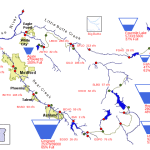New jail tax would do more harm than good
by Eleanor Ponomareff and Sarah Westover
Sunday, November 17th 2019
Do Jackson County taxpayers want to raise taxes to spend at least $171 million to triple county jail capacity, while building a new jail that costs at least $28 million a year to operate?
Would voters support a new jail tax that actually gives the county less incentive — not more — to reduce crime by dealing with underlying problems like mental illness, substance addiction, homelessness, and poverty?
Why hasn’t the county committed to fund and implement more cost-effective alternatives that have worked in other counties to reduce the number of people who are jailed in the first place?
Why support a tax that will result in thousands more residents being unnecessarily saddled with new trauma and a jail record that makes it harder to get jobs or rental housing?
These are questions that local residents have asked us, as their elected representatives. So far, the county has not provided good answers.
County officials put the jail tax before local city councils last spring without prior public participation and demanded that council members endorse it.
According to the sheriff’s website, a new jail would be built with maximum capacity of 896 beds — about three times the capacity of the current jail. (The county says it would “strive” to limit the number of inmates at any one time to 800.)
The county said a cost of $166 million was an “estimate.” Already, that “estimate” has been increased by another $5 million, suggesting that no one knows what a new jail finished in 2024 will actually cost to build or operate, or how much profit the construction company will make.
With tripled jail capacity, the county will have an overwhelming incentive to fill those beds with an extra 500 to 600 people per night, leading to more profiling of people with mental illness or addiction, homeless people, youth, and people of color. After all, what county official would want to be in the politically embarrassing position of having to explain why taxpayers spent $171 million or more on new jail beds that weren’t needed?
In addition, taxpayer funds that might have gone to prevention, diversion, and treatment programs will have been used up on the jail.
When several city councils refused to rubber-stamp a tripling of jail capacity, the county established an “advisory committee.” We attended those meetings, where the county simply insisted on the same jail tax proposal. Promised outcomes generally were simply asserted or “proven” with anecdotes, rather than with firm statistical analyses or funding commitments.
For example, the county said if it could just hold inmates for a few more days on average, they would be provided services to address underlying problems and lower repeat crime rates. But no evidence was provided regarding how many days are supposedly needed, what commitments the county would make about services, or whether a tripling of capacity was needed to accomplish that goal. There also was no recognition of the damage avoidable incarceration does to many individuals.
The county also did not bring in experts from other counties to describe more cost-effective programs they have implemented. Instead, community groups had to take the lead.
For example, the Rogue Action Center and NAMI-SO (National Alliance on Mental Illness Southern Oregon) arranged for a presentation by officials from CAHOOTS, a program in Lane County. They use mental health professionals in mobile crisis units to respond to more than 24,000 calls per year that would otherwise be channeled to law enforcement and in many cases would result in unnecessary and harmful incarceration. The program in Lane County saves more than $15 million per year.
Similarly, NAMI-SO arranged for officials from Marion County to make a presentation on Nov. 13 about programs that have drastically increased the percentage of people diverted to services and treatment before ever going to jail.
Could Jackson County use programs like these to help more people, reduce crime, and make the current jail facility more manageable?
Could some or all of the proposed jail money be used for prevention, diversion, and treatment to avoid a tripling of capacity?
Is $171 million to triple jail capacity the best use of money when Jackson County just laid off 200 mental health professionals in 2017?
We have no doubt that some people get help after being in jail. But without exploring proven, cost-effective alternatives, the current jail tax proposal will mean there will be thousands more who will be unnecessarily harmed, underlying problems will not be addressed, and costs to taxpayers will continue to rise without end.
Eleanor Ponomareff is a member of the Talent City Council. Sarah Westover is a member of the Phoenix City Council.





